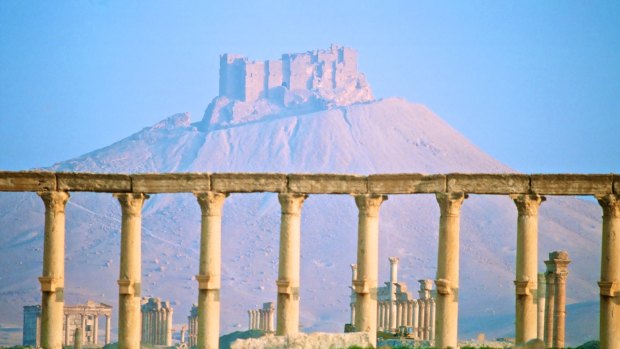This was published 8 years ago
Damage to ancient Syria and its people remains a mystery
By Tim Richards

Castle Alhsn crusade fortess in Syria, bombed in 2013.Credit: iStock
The small boy shyly held out a coin to us, neatly reversing the tradition of baksheesh, whereby visitors would tip locals for providing services. We had to laugh at the gesture. We'd just come from Cairo, the world capital of baksheesh, a busy, ancient, exciting city where the timely exchange of loose change helped everyone get through their days.
Things were different here on a quiet hilltop in western Syria, in the spring of 1994. We'd clambered up the hill to get a better view of the Crac des Chevaliers, a magnificent medieval castle built by Crusader knights in the 12th century and captured by the Egyptian Sultan Baybars in the 13th.
It was a wonderful place to visit in the mid-'90s, a vast edifice of white stone set above green slopes, emblematic of the country's complex history. Within the castle walls, visitors could admire elements of east and west in its design, including intricate Islamic art curved over doorways. On the ramparts, we walked along paths unnervingly free of guard rails, looking out on the green hills below.
I wonder where that boy is now. He'd be in his mid-20s, a prime age to be caught up in the violence that's raged across Syria since its civil war began in 2011. Has he taken up arms, been forced to fight, or fled his country with the tens of thousands seeking refuge in Europe?
The castle, a World Heritage site, has reportedly been bombed and shelled. But I wonder more about the people we met back then. The truckload of Syrian army engineers who gave us a lift from the ruins of the Church of St Simeon Stylites, dropping us off at the nearest village so we could catch a minibus back to Aleppo.
The two young men we met for drink in the city of Homs, who wanted to practise their English. The resident who rescued us from utter confusion in the maze-like Old Town of Damascus, guiding us to the nearest gate that would lead us back to the 20th-century city. The cafe owner at Palmyra who didn't mind us sitting for hours while we waited for an uncertain onward bus to turn up.
Palmyra. I'd been trying to avoid thinking about this beautiful Roman-era city, ever since I heard it had been captured earlier this year by the forces of Islamic State.
Though I knew they were likely to destroy its antiquities once they occupied the site, I hoped it could somehow be avoided. Perhaps they would have to suddenly withdraw, or be low on explosives or, who knows, just look at the beautiful ruins and be moved to spare them.
Wishful thinking on my part. In August, the occupiers demolished the ancient Temple of Baal Shamin with explosives, days after murdering 82-year-old archaeologist Khaled al-Asaad for refusing to assist them. His death forced me to pay attention, and to dig out the photos I took of Palmyra's graceful ruins back when holiday snapshots became tangible prints.
Palmyra was the highlight of that trip. Staying in cheap accommodation in the adjacent town of Tadmor, my wife Narrelle and I were able to visit Palmyra's extensive ruins both early and late in the day, avoiding the coachloads of day-trippers that regularly arrived from Damascus.
It was a special experience, being out among the ghosts of the past, the desert sun throwing the bone-coloured buildings into sharp relief – the temples, the agora, the remains of the ancient baths. While I grieve for these ancient treasures, I hope that something might be salvaged once IS passes from history.
Perhaps some structures have been spared; maybe the Temple of Baal Shamin and its fellows can be rebuilt. And I think about the many Syrians we interacted with on that journey: the guides and hotel owners and bus drivers and restaurateurs and passers-by. And particularly that small boy who gave us a coin on a hilltop above a castle.
I hope they've managed to survive the devastation wrought on their country by not only IS, but by Syria's president Bashar al-Assad, a man who thinks nothing of launching air strikes against his own people.
Lots of maybes there, and no firm answers. But in memory of Palmyra, and of a lost time in which Syrians and visitors could enjoy the echoes of its greatness, I'll look again at the photos I took in 1994. They were snapped with a cheap camera of the era, so they're not masterpieces. But they take me back to a happier time.
Thank god the carefree, sunburnt 29-year-old me, sitting on an ancient stone wall at Palmyra while smiling for the camera, had no way of glimpsing the future. It might have been too much to bear. It almost feels too much to bear right now.
Donations to assist victims of Syria's civil war can be made via the Save the Children Syrian refugee crisis appeal: savethechildren.org.au/syria.
Sign up for the Traveller Deals newsletter
Get exclusive travel deals delivered straight to your inbox. Sign up now.